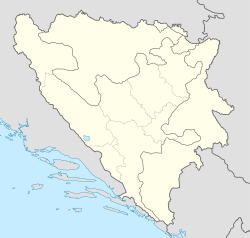Bosansko Grahovo
|
Bosansko Grahovo Босанско Грахово |
||
|
|
||
| Basic data | ||
|---|---|---|
| State : | Bosnia and Herzegovina | |
| Entity : | Federation of BiH | |
| Canton : | 10 | |
| Coordinates : | 44 ° 9 ' N , 16 ° 22' E | |
| Height : | 827 m. i. J. | |
| Area : | 780 km² | |
| Residents : | 3,091 (2013) | |
| Population density : | 4 inhabitants per km² | |
| Telephone code : | +387 (0) 34 | |
| Postal code : | 80270 | |
| Structure and administration (as of 2016) | ||
| Mayor : | Duško Radun ( SNSD ) | |
| Website : | ||
Bosansko Grahovo ( Serbian - Cyrillic Босанско Грахово , also just Grahovo ) is a small town and municipality of the same name in the west of Bosnia and Herzegovina near the border with Croatia . It belongs to Canton 10 of the Federation of Bosnia and Herzegovina and is one of three municipalities in the Federation that are mostly inhabited by Serbs.
geography

Bosansko Grahovo is located on the Grahovsko polje plateau at an altitude of about 800 m between the Dinara , Šator and Uilica mountain ranges .
Neighboring municipalities are Drvar , Glamoč and Livno in Bosnia-Herzegovina and Gračac , Kijevo and Knin in Croatia .
history
During the Bosnian War , Bosansko Grahovo was under the control of the Army of the Republika Srpska until Croatian troops conquered the area in late July 1995 in the immediate run-up to Operation Oluja , which led to the flight of a large part of the Serbian population. To date, numerous ruins in the center of the village have not been renovated (as of 2018).
population
At the 1991 census, the municipality of Bosansko Grahovo had 8,311 inhabitants, including
- Serbs - 7,888 (94.91%)
- Croatians - 226 (2.71%)
- Yugoslavs - 135 (1.62%)
- Bosniaks - 12 (0.14%)
- Others - 50 (0.62%)
2,096 inhabitants lived in the main town.
- Serbs - 1,999 (95.37%)
- Yugoslavs - 61 (2.91%)
- Croatians - 14 (0.66%)
- Bosniaks - 6 (0.28%)
- Others - 16 (0.76%)
Today the Serbs again make up the absolute majority of the population. Even before the war, the community was marked by strong migration. In 1971 the population was 10,565.
The municipality comprises 35 places: Bastasi, Bosansko Grahovo, Crnac, Crni Lug, Donje Peulje, Donji Kazanci, Donji Tiškovac, Duler, Gornje Peulje, Gornji Kazanci, Grkovci, Isjek, Jaruga, Kesići, Korita, Luka, Maleševci, Malo Tičevo, Marinkovci, Mračaj, Nuglašica, Obljaj , Pečenci, Peći, Preodac, Pržine, Radlovići, Resanovci, Stožišta, Ugarci, Uništa, Veliko Tičevo, Vidovići, Zaseok and Zebe. Many of these villages consist of only a few homesteads.
economy
The community is characterized by agriculture and forestry.
traffic
Bosansko Grahovo is located on the highway from Drvar to Knin , which was of great strategic importance, especially during the Bosnian and Croatian wars . The rest of the road network is not well developed. Uništa , west of the Dinara massif, can only be reached by car via Croatia.
In the far west of the municipality, directly on the Croatian border, the Una Railway also crosses the municipality, which once connected Zagreb with the Dalmatian coast, but has not been served by passenger trains since the end of the Bosnian War .
Personalities
- Gavrilo Princip (1894–1918) was born in the district of Obljaj . He killed the Austrian Archduke Franz Ferdinand in the 1914 assassination attempt in Sarajevo .






